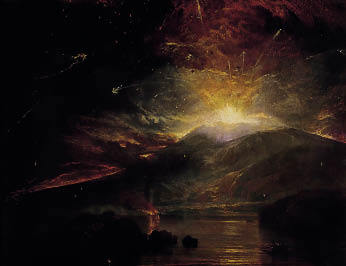Volcano: Turner to Warhol
Compton Verney, until 31 October
On my desk is a lump of lava, a memento of Vesuvius. It doesn’t look like much, but neither does the volcano from the cinder track that winds around to its summit. From close to, Vesuvius is a giant ash heap; it’s from across the bay that the magic works.
Never does distance lend more enchantment to the view than in the case of volcanoes: when they’re exploding they’re plain dangerous, and when not they’re really rather dull. Their allure is as elusive as a rainbow’s, and it was in rainbow colours that Andy Warhol painted Vesuvius in 1985, making it look like a Neapolitan ice cream blown under pressure through the end of a cone.
Warhol’s ‘Vesuvius’ is only the most extreme variation on the volcanic theme in Compton Verney’s Volcano: Turner to Warhol, an exhibition of some 200 images and associated objects that takes us on an imaginative world tour of exploding mountains, from Heimaey to Nyiragongo and Cotopaxi to Fuji. It even shows us the knock-on effects of Krakatoa on Chelsea in a series of 1883 skyscapes by the Thames view painter William Ashcroft (sunsets were so lurid that fire engines were called out). But the show’s arrangement is not geographical or even historical. As befits its disaster movie title, it follows the volcano’s dramatic cycle from quiescence through eruption to regeneration.
This last phase is what attracts volcano-dwellers, but not tourists. The birth of volcano tourism coincided with the Romantic era, to which the earth’s magma apparently responded with a sympathetic spurt of activity. But not all volcano painters witnessed eruptions. Turner’s ‘Eruption of the Souffrier Mountains in the Island of St Vincent’ (1815) was painted from a drawing by a local plantation owner — and looks a little like the Lake District with lava bombs — while Joseph Wright of Derby’s convincingly gestural sketch of ‘Vesuvius in Eruption’ predated the big event of 1778 by four years. John Martin’s Campi Phlegraei are of course pure fantasy, inspired by James Ridley’s oriental romance, Sadak and Kalasrade, whose hero is literally tested in the volcanic fire while searching for the Waters of Oblivion.
The test of authenticity, with volcano paintings, is not in the fire but in the smoke. The 18th-century artist-priest Padre Antonio Piaggio, who filled eight books with studies of Vesuvius for Sir William Hamilton, did for ash clouds what Constable did for vapour ones, earning his patron’s affirmation, ‘no man was ever more attached to the truth’. The Norwegian artist Johan Christian Dahl, commissioned to paint an ‘Eruption of Vesuvius’ (1820) for a local professor of mineralogy, showed the volcano authentically choked with smoke, as did the English marine painter Clarkson Stanfield, lucky enough to catch an eruption in 1839. There is also more smoke than fire in Keith Grant’s modern aerial view of the 1973 eruption of the Icelandic volcano Eldfell, pictured from 20,000ft as nature’s mushroom cloud.
Grant’s is an observational record, albeit from an unusual viewpoint, as is James P. Graham’s wonderfully atmospheric film of Stromboli, Iddu, shot in 360° with 12 cameras (there’s only room for a 60° segment here, but the rumblings permeate the galleries). Other contemporary artists milk volcanoes for metaphors of instability. Ilana Halperin’s etching series ‘Emergent Landmass’ (2006) records the brief appearance off Sicily in 1831 of the volcanic island Ferdinandea, which sparked a sovereignty dispute and then promptly sank, while Dieter Roth’s sequence of collotypes of ‘Surtsey’ (1973–4) transforms the volcanic island that appeared off Iceland in 1963 into an île flottante.
Postmodern detachment may lend irony to the view, but the Eyjafjallajökull news headlines pinned up in the gallery’s Resource Room remind us of how huffy we get when volcanoes impact on us. And it could have been worse. As the show’s curator James Hamilton notes in his informative accompanying booklet, the 1783 eruption of the Icelandic volcano Laki caused bread shortages that led indirectly to the French Revolution.






Comments